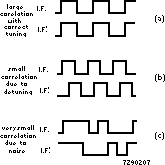TDA7000 - A Complete FM Radio on a Chip
Page 4 of 11
Corralation muting system with open FLL
A well-known difference between f.m. and a.m. is that, for f.m., each station
is received in at least three tuning positions. Fig.6 shows the ftequency
spectrum of the output ftom the demodulator of a typical portable f.m. radio
receiving an r.f. carrier ftequency-modulated with a tone of constant frequency
and amplitude. In addition to the audio response at the correct tuning point
in the centre of Fig. 6, there are two side responses due to the flanks
of the demodulator S-curve. Because the flanks of the S-curve are non-linear
the side responses have increased harmonic distortion. In Fig.6, the ftequency
and intensity of the side responses are functions of the signal strength,
and they are

Fig.6 Audio signal of a typicel portable radlo " a furmtIon of tuned frequency with r.f. Input os a peremeter. The modu- lation frequency and amplituds, are both oonstant
separated ftom the coirect tuning point by amplitude minima.
However, in practice, the amplitude minitna are not well defined because
the modulation frequency and index are not constant and moreover, the side
responses of adjacent channels often overlap.
High performance f.m. radios incorporate squelch systems
such as signal-strength-dependent muting and tuning-deviation-dependent
muting (Ref.1) to suppress side responses. They also have a tuning meter
to facilitate correct tuning. Although the TDA7000 is mainly intended
for use in portables and clock radios, it incorporates a very effective
new correlation muting system which suppresses interstation noise and
spurious responses due to detuning to the flanks of the demodulator S-curve.
The muting system is controlled by a circuit which determines the correlation
between the waveform of the i.f. signal and an inverted version of it
which is delayed (phase shifted) by half the period of the nominal if.
(180*). A noise generator wor~s in conjunction with the muting system
to give an audible indication of incorrect tuning.

Figure 7 diustrates the function of the muting system. Signal 117' is derived by delaying the i.f. sipal by half the period of the nominal i.f. and inverting it. With correct tuning as shown in Fig.7(a), the waveform of the two signals are identical resulting in large correlation. In this situation, the audio signal is not muted. With detuning as shown in Fig.7(b), signal IF' is phase-shifted with respect to the i.f. signal. The correlation between the two waveforms is therefore small and the audio output is muted. Figure 7(c) shows that, because of the low Q of the i.f. filter, noise causes considerable fluctuations of the period of the i.f. signal waveform. There is then small correlation between the two waveforms and the audio is muted. The correlation muting system thus suppresses noise and side responses due